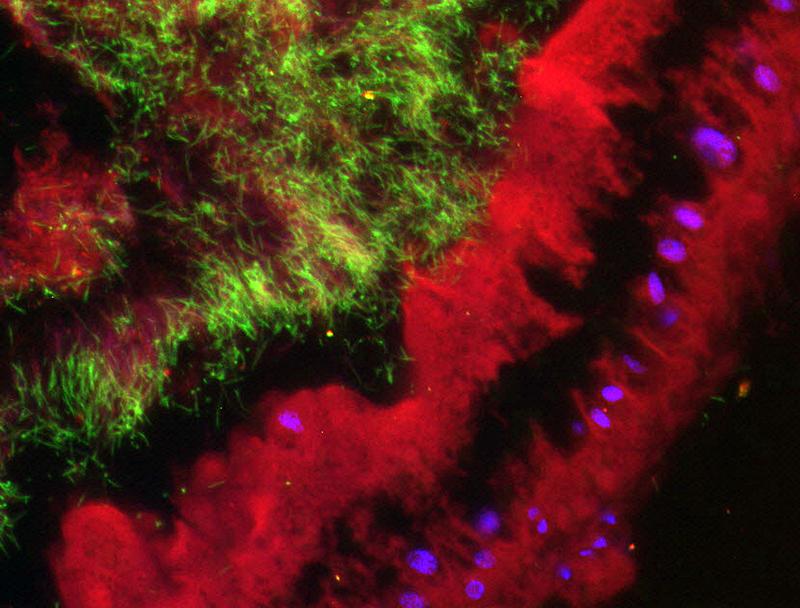
Insects Adapt to New Diets Through Microbe Partnership

Fluorescence in situ hybridization (FISH) of symbiotic microbes in the insect gut using probes for general bacteria (red), Coriobacterium (green), and the host cell nuclei (purple).
Sailendharan Sudakaran / Max Planck Institute for Chemical Ecology
Insects are the most diverse animal group on earth. Many of them feed on plants, and they are constantly challenged by the diverse direct and indirect defenses of their food plants as well as an imbalanced nutrient composition.
In response, the insects are continuously evolving different behavioral, morphological and biochemical adaptations to overcome the plant defenses. Additionally, some species rely on symbiotic microbes to deal with the plants’ nutritional challenges. Scientists of the Max Planck Research Group Insect Symbiosis and the Experimental Ecology and Evolution Group at the Max Planck Institute for Chemical Ecology in Jena, Germany, have now found that acquiring a group of bacterial symbionts that are localized in the gut enabled a group of insects to successfully exploit a food source that was previously inaccessible to them and lead to the diversification within this new ecological niche (The ISME Journal, May 2015).
Hemipterans or true bugs have been extensively studied in terms of the symbionts associated with them. Previous studies have shown that most hemipterans feeding on plant saps harbor microbial symbionts intracellularly in specialized host cells within their body. In contrast, bugs that feed on the reproductive parts of plants (flowers ovules and seeds) are often associated with extracellular symbionts confined to specialized structures along the gut or localized directly in the mid-gut.
These symbionts are generally known to provision nutrients to their insect hosts that are otherwise deficient in their food source and may in some cases also help neutralize plant toxins. Among these are the firebugs (Pyrrhocoridae) that feed on the seeds of plants belonging to plant order Malvales. Seeds of Malvales are rich in toxic allelochemicals and poor in some essential nutrients.
As a result, relatively few species of herbivorous insects rely on Malvales seeds as their food source. Previous studies have shown that European firebugs (Pyrrhocoris apterus) harbor gut microbes that are essential for their successful development (see our press release “Bugs need symbiotic bacteria to exploit plant seeds”, http://www.ice.mpg.de/ext/976.html, January 9, 2013) and in particular bacterial symbionts from the Coriobacteriaceae family provide B vitamins to their insect host (see our press release “The nutritionists within”, http://www.ice.mpg.de/ext/1216.html, December 1, 2014).
However, it remained unknown whether the gut microbes identified in firebugs are widespread across different firebug species and whether the acquisition of the gut microbes enabled the firebugs to successfully switch from their ancestral food source to the ecological niche of the Malvales.
To address these questions, the researchers used a high-throughput sequencing technology to characterize the gut microbiota associated with multiple members of the firebug family and its sister family, the bordered plant bugs or Largidae. They discovered that many different members of the firebug family share the same core microbiota. Interestingly, all the insect taxa that harbored the core microbiota were confined to a single clade within the Pyrrhocoridae, while the core microbes were completely absent from their sister family, the Largidae.
According to phylogenetic analyses, the association between firebugs and the core microbiota originated around 81 million years ago (in the late Cretaceous) which coincided with the emergence of their host plants, the Malvales. ”The acquisition of the gut-associated core microbiota apparently enabled firebugs to successfully overcome the plants’ defenses and nutritional shortcomings and utilize the Malvales seeds as a food source,” explains Sailendharan Sudakaran, the first author of the study. Consequently, the high species diversity observed within the group of firebugs harboring the specialized gut microbiota suggests that the microbial symbionts have been instrumental in allowing the bugs to diversify into this ecological niche and expand into the large number of species observed today.
Insects are generally associated with a high diversity of microbial symbionts, and recent advances in next-generation sequencing technologies have allowed for a significant increase in knowledge on the functional importance of symbionts for the hosts’ nutrition. However, the relevance of symbiosis in allowing hosts to switch to a new diet and then diversify into many different species still remains little studied. The present publication provides an important case study.
“To us the most exciting question that remains to be answered is how general the phenomenon of evolutionary innovation through symbiosis is, especially with regard to the adaptation of their insect hosts to a wide range of host plants. In order to get a better understanding of the impact of symbiosis, there should be more focus on the nutritional ecology of their insect hosts before and after the acquisition of a particular symbiont or group of symbionts”, the authors conclude.
Many insects are serious pests to commercially valuable crops. Gaining a better understanding of the role of symbiosis in the insects’ adaptation to a wide range of plants may provide us with novel leads to a biological control of major agricultural pests. [SS/AO]
Original Publication:
Sudakaran, S., Retz, F., Kikuchi, Y., Kost, C., Kaltenpoth, M. (2015). Evolutionary transition in symbiotic syndromes enabled diversification of phytophagous insects on an imbalanced diet. The ISME Journal. doi: 10.1038/ismej.2015.75
http://dx.doi.org/10.1038/ismej.2015.75
Further Information:
Dr. Martin Kaltenpoth, Max Planck Institute for Chemical Ecology, Hans-Knöll-Straße 8, 07745 Jena, Germany, Tel. +49 3641 57-1800, E-Mail mkaltenpoth@ice.mpg.de
Sailendharan Sudakaran, Max Planck Institute for Chemical Ecology, Hans-Knöll-Straße 8, 07745 Jena, Germany, Tel. +49 3641 57-1804, E-Mail ssudakaran@ice.mpg.de
Contact and Picture Requests:
Angela Overmeyer M.A., Max Planck Institute for Chemical Ecology, Hans-Knöll-Str. 8, 07743 Jena, Germany, +49 3641 57-2110, E-Mail overmeyer@ice.mpg.de
Download of high-resolution images via http://www.ice.mpg.de/ext/downloads2015.html
http://www.ice.mpg.de/ext/insect-symbiosis.html (Max Planck Research Group Insect Symbiosis)















